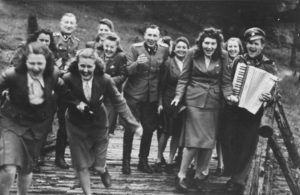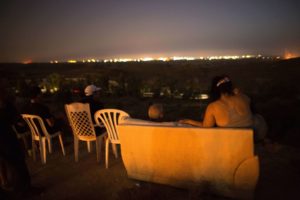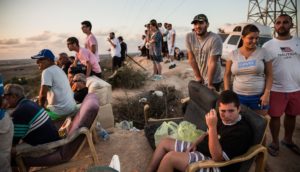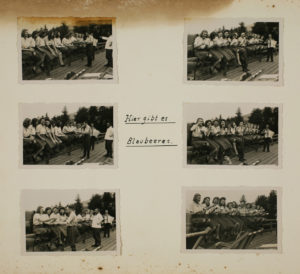Disclaimer: Since it is easy temptation to conflate one’s intentions when taking a class with what students take away from it, I’ll try to stick to reporting how the class unfolded.
I had five images on a pen drive by way of ‘class material’ as I headed for my first session at Chowringhee High School on December 7th. That and a sense of some notions the students seemed to hold firmly (from my observations in a class I had previously sat in for) that I wanted to encourage them to re-view/treat with doubt. I also hoped to engage them in discussion that would encourage criticality in their perceptions of these events and help them step beyond a disengaged token sympathy with a specific race—an easy tendency that often solidifies into what are at heart, race-driven stereotypes (I had already heard opinions such as ‘All jews are gentle’, ‘Jews are shrewd’, ‘Jews are all somehow more intelligent than others’ from the students and one of their teachers previously).
What I did not have was confidence that any of this would ‘work’.
A few of the students waited for their history teacher to look elsewhere before raising their hands in response to my question. I’d asked how many of them dislike history. Unsurprisingly, the reasons mostly centred on ‘Too many dates!’ and ‘But it all happened so long ago and far away’s.

From the Höcker Album, a collection of photographs believed to have been taken and collected by Karl-Friedrich Höcker, an officer for the SS during the Nazi regime in Germany.
Who are they?
Jews. Europeans? Humans, one safe player said. ‘They seem to be school students during tiffin break’, in response to the second. When I shared that these were SS workers (or more familiar to the students, Nazis), they were horrified. Were they laughing and on a picnic because they were evil and knew that Jews were being gassed to death, a few of the students wondered aloud, their teacher was convinced. But what does that have to do with a picnic, others argued. I’d chosen these images specifically to introduce some doubt into the concrete myth the students seemed to have painted out of fascism: a giant repulsive monster emblazoned with Nazi swastikas that always arrives with a drumroll and exterminates innocent races irrationally, a series of vile acts only evil inhuman people could perform and most importantly, an element of a past too far back to really affect our lives.
(One of the teachers and I suggested Schindler’s List, The Boy in the Striped Pyjamas and The Reader as mainstream filmic attempts to explore the holocaust through individual narratives set in un-ignorable socio-political contexts.)
The question we moved on to after this discussion was: Can a victim or a survivor of violence also go on to become a perpetrator of violence? Or does the experience of suffering stop such a possibility?
We explored this question in the context of bullying and other experiential examples the students offered up before I shared with them a controversial illustration of Anne Frank in a keffiyeh which was circulated by the Palestinian Solidarity Committee in the form of flyers in March 2018, earning outrage from many members of Jewish communities in South Africa.
‘Why do you think people of the Jewish communities were offended at this image?’ Since the students were barely familiar with Israel or Palestine (understandably, as it does not feature in their syllabus), guessing/imagining an answer to this question was difficult for them. So I asked them what these two names evoked for them. The only fact they were certain of was that Israel was a Jewish state. I next asked why then Israel had not pitched in to help the Jewish during the period of holocaust. While both attending teachers visibly fretted at what they saw as their students’ inadequate ‘gk’, the students thought hard to try and come up with reasons that made sense to them. When through this riddle chase we finally arrived at the answer, that Israel had not existed as a political entity during the second WW and the holocaust, the students seemed taken aback. Nations as dynamic unstable entities was not a familiar idea. This was the point of entrance into a brief but expansive discussion on who, when and out of what, formed Israel, and the lasting and ongoing repercussions of the same. That dates could be more than a pain requiring to be memorized and could be used as markers to link what was happening in different parts of the world, appeared to be a novel notion to the students. Talking about the ideas that go into the construction of a nation, a short digression into where India was located in the context of the holocaust*, and what it means to have a ‘homeland’, we wrapped up the discussion that arose from the question ‘Can a victim or a survivor of violence also go on to become a perpetrator of violence?’, with these two images.

Israelis watched the bombing of Gaza from a couch dragged to a hill overlooking the Palestinian territory. Credit-Menahem Kahana/Agence France-Presse — Getty Images

Israelis gathered on a hilltop outside the town of Sderot on Monday to watch the bombardment of Gaza. Photo by Andrew Burton/Getty Image
Presenting the students with these, I asked them what they thought these were photos of. Many said that friends and families were watching a football or some sport match together, some were uncertain if it was bright enough to do so, a few expressed confusion at the displaced furniture. When I shared the captions with the students, they fell silent.
The point of using these images was not to simply shock. It was to encourage a more layered understanding of violence and, keeping in mind the governing ethos of the Anne Frank: A History for Today project, to use what we learn from our history lessons to understand the world around us. Amidst the statistics, the matter of fact details of violence, the lists of ’causes’ and historical factors leading up to the war that most school history text books offer when addressing the WW II and the holocaust, there’s barely any scope for conversation in the average classroom around the ideas and beliefs that form the kernel of what grow on to become historical crimes of this scale. The use of these images and the glimpse of ongoing atrocities they offer, hoped to unsettle the passive ‘ease’ of reading/understanding the holocaust as a singular long ago horror whose sensational details can be temporarily glossed over to be shocked at, before being forgotten for the next history test’s syllabi.
As I was packing to leave, two students asked me where they could further look up two of the topics discussed, while another shared that she had never given much thought to the holocaust and the Second WW as being connected to the formation of the UN, much less to India* and news pieces on Gaza, and that the class had painted a map of sorts in her mind. Both teachers remarked that locating a historical event (the holocaust) in a maze of other related histories as an approach was both, engrossing for them to sit through themselves, as well as of pedagogic interest for potential use in the classroom.
While what these discussions tangibly achieved/did not, may be quite impossible to record or measure, I hope they made a sufficient impression in the students’ (and teachers’) minds to persist as questions.
*I briefly mentioned to them this little circulated Indian connect to the holocaust.
-Ranita.

